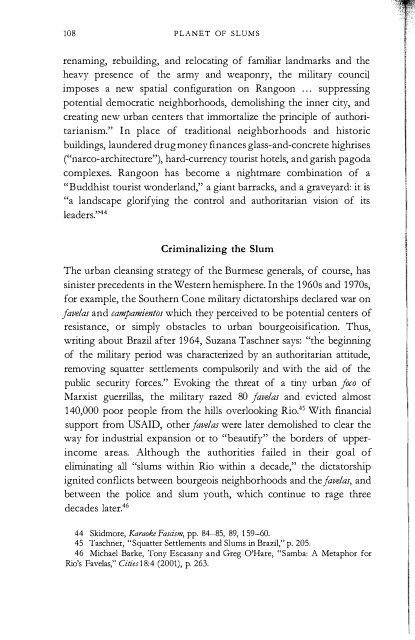Untitled - Rebel Studies Library
Untitled - Rebel Studies Library
Untitled - Rebel Studies Library
Create successful ePaper yourself
Turn your PDF publications into a flip-book with our unique Google optimized e-Paper software.
108 PLANET OF SLUMS<br />
renaming, rebuilding, and relocating of familiar landmarks and the<br />
heavy presence of the army and weaponry, the military council<br />
imposes a new spatial configuration on Rangoon ... suppressIng<br />
potential democratic neighborhoods, demolishing the inner city, and<br />
creating new urban centers that immortalize the principle of authoritarianism."<br />
In place of traditional neighborhoods and historic<br />
buildings, laundered drug money finances glass-and-concrete highrises<br />
("narco-architecture"), hard-currency tourist hotels, and garish pagoda<br />
complexes. Rangoon has become a nightmare combination of a<br />
"Buddhist tourist wonderland," a giant barracks, and a graveyard: it is<br />
"a landscape glorifying the control and authoritarian vision of its<br />
leaders."44<br />
Criminalizing the Slum<br />
The urban cleansing strategy of the Burmese generals, of course, has<br />
sinister precedents in the Western hemisphere. In the 1960s and 1970s,<br />
for example, the Southern Cone military dictatorships declared war on<br />
Javelas and campamientos which they perceived to be potential centers of<br />
resistance, or simply obstacles to urban bourgeoisification. Thus,<br />
writing about Brazil after 1964, Suzan a Taschner says: "the beginning<br />
of the military period was characterized by an authoritarian attitude,<br />
removing squatter settlements compulsorily and with the aid of the<br />
public security forces." Evoking the threat of a tiny urban Joco of<br />
Marxist guerrillas, the military razed 80 Jave/as and evicted almost<br />
140,000 poor people from the hills overlooking Rio.45 With financial<br />
support from USAID, other Jave/as were later demolished to clear the<br />
way for industrial expansion or to "beautify" the borders of upperincome<br />
areas. Although the authorities failed in their goal of<br />
eliminating all "slums within Rio within a decade," the dictatorship<br />
ignited conflicts between bourgeois neighborhoods and the Javelas, and<br />
between the police and slum youth, which continue to rage three<br />
decades later.46<br />
44 Skidmore, Karaoke Fascism, pp. 84-85, 89, 159-60.<br />
45 Taschner, "Squatter Settlements and Slums in Brazil," p. 205.<br />
46 Michael Barke, Tony Escasany and Greg O'Hare, "Samba: A Metaphor for<br />
Rio's Favelas," Cities 18:4 (2001), p. 263.<br />
HAUSSMANN IN THE TROPICS 109<br />
Meanwhile, in Santiago in 1973, one of the first acts of the<br />
Pinochet dictatorship - after murdering the leadership of the popular<br />
Left - was to reestablish middle-class hegemony in the central city by<br />
expelling squatters (some 35,000 families) from the shanty poblaci6nes<br />
and callampas that the Allende government had tolerated.47 "The<br />
openly stated objective," says community-organization researcher<br />
Hans Harms, "was to create 'homogeneous socio-economic areas in<br />
the city.' ... A climate of isolation and fear was created with the disbanding<br />
of all neighbourhood organizations under 30 years of<br />
Pinochet's military dictatorship."48 Following a revival of political<br />
activism in 1984, the regime again unleashed the wrecking crews<br />
against the pob/adores in another round of "eradications"; the cumulative<br />
result, as Cathy Schneider explains in her important history of<br />
neighborhood resistance to the dictatorship, was to force evictees and<br />
young families to double up with friends or relatives. "The percentage<br />
of families living as allegados (with more than three persons per<br />
bedroom) grew from 25 percent in 1965 to 41 percent in 1985." 49<br />
A counterinsurgency-driven strategy of slum removal was first<br />
adopted in Argentina during the military junta of 1967-70. As Cecilia<br />
Zanetta has emphasized, the government's "Plan de Erradicacion de<br />
Villas de Emergencia" was targeted specifically at radicalized selfgovernment<br />
in the shantytowns, and the evictees were forced to<br />
undergo a phase of "social adjustment" before being resettled in the<br />
periphery. However, this first military attempt to roll back informal settlement<br />
was only partly successful, and with the restoration of civilian<br />
rule in the early 1970s, the slums again became hotbeds of radical<br />
Peronist and socialist agitation. When the generals came back into<br />
power in March 1976, they were determined to destroy the villas miseri.as<br />
once and for all; during the terrible years of el Promo, rent control was<br />
repealed, 94 percent of the "illegal" settlements in Gran Buenos Aires<br />
were razed, and 270,000 poor people were rendered homeless. Rankand-file<br />
organizers, including lay Catholics as well as leftists, were<br />
systematically "disappeared." As in Chile, the liquidation of slum-based<br />
47 Alfredo Rodriguez and Ana Maria Icaza, "Chile," in Azuela, Duhau, and Ortiz,<br />
Evictions and the Rightto Housing, p. 51.<br />
48 Harms, "To Live in the City Centre," p. 198.<br />
49 Cathy Schneider, Shantytown Protest in Pinochet Chile, Philadelphia 1995, p. 101.


